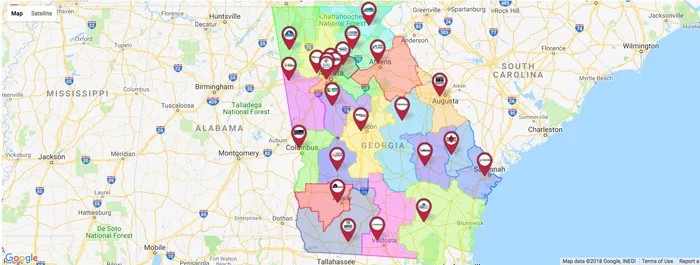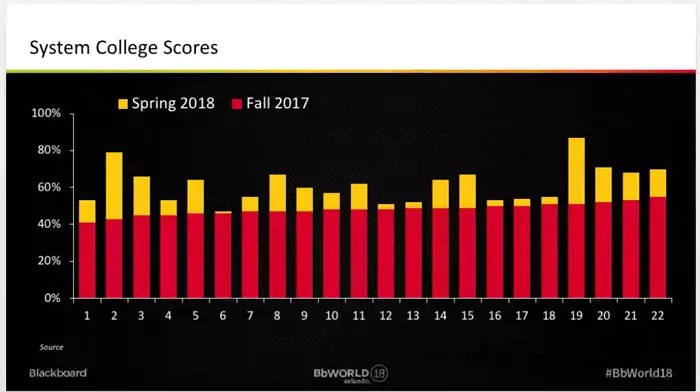One Foot in Front of the Other
with Nikki Stubbs and Pam Warren, Technical College System of Georgia
University context: Answering Workforce Needs
Comprised of 22 colleges spanning 85 locations, the Technical College System of Georgia (TCSG) is an engine for career advancement and workforce development, with 98% of our 27,000 graduates last year finding employment or continuing their education. As part of our mission to increase student access to affordable, high quality learning and training, our HOPE Career Grant provides free tuition for eligible students who enroll in a program related to one of Georgia’s strategic industries. Our curricula and standards align with business and industry requirements while our partnerships with Georgia’s four-year universities and colleges offer seamless transitions for students who wish to further their academic pursuits.

Goals for Ally: Establish a Sense of Direction
Our team at the Georgia Virtual Technical Connection (GVTC) works with all 22 of our colleges to help them enhance their online offerings and improve their use of digital tools. Following an initial effort by the colleges to address the accessibility of their websites, we began taking some first steps to support the colleges in fixing accessibility issues with their course content, focusing on five high-impact areas: Images, Styles, Content organization, Links, and Color. As we anticipated, helping instructors fix their accessibility issues required more than just emailing them a checklist and pointing them to the WCAG standards, but it got the conversation started.
We believed Ally would help move instructors out of the dark, and provide them the insights to take a more iterative approach to improving one content item at a time.Just a few months after beginning our initiative, the US Access Board published their 508 Refresh requiring campuses to meet digital accessibility compliance by the end of the year. Needless to say, this induced some panic among instructors, who under pressure by such a mandate may have considered changing the format of their course environment. We needed tools to help us make strategic sense of the challenges in front of us and better support instructors. And that’s when we discovered Ally.
Implementation Strategy: Be Better Today
For our team at the GVTC, establishing consistent messaging and creating robust training resources for our colleges was essential in preparing for our Ally roll-out. Collaborating with our “Points of Contact” (POCs) at each of the colleges, we used a train-thetrainer approach to model instructor communications about the purpose of the Ally indicators, stressing that instructors didn’t need to fix everything at once or start deleting content from their courses.
We wanted to be clear: The goal is not to be perfect by the end; the goal is to be better today.We created modules and courseware that covered accessibility and Universal Design for Learning in our training resources, focusing on the ways that accessible content could benefit the learning experiences and outcomes of all students. We took advantage of existing Blackboard resources to design our training content, and increased our presence at faculty development and consortium meetings. To help instructors overcome misconceptions that accessible content had to be boring content, we adopted Thomas Tobin’s “plus-one” approach, which encourages instructors to provide students an alternative for content that may have accessibility issues.
Evaluation and Findings: Models for Success
We implemented Ally across all 22 colleges the same day, and the results were illuminating. While there was indeed a mountain of content remediation work in front of us, Ally provided the essential “whys” and “hows” about accessibility to instructors within their course, making the process less intimidating and more guided. Even a few instructors who were initially resistant to the accessibility mandates were pleased to have access to a tool that brought transparency to the process. Each of the colleges owned their Ally roll-out strategy, allowing us- from a system perspective- to analyze what initiatives yielded the best results. Their institutional reports revealed positive increases in accessibility scores across all 22 colleges, with two schools seeing increases of over 36% in a single term! One college’s distance learning office sent out weekly tips and tricks to instructors, focusing on a single issue explained in a one-page micro-learning guide.
I have discovered that once you change your mindset to an all-inclusive learning environment, it is exponentially easier to create instructional materials than doing things the old way” - InstructorThe other college established an internal goal of reaching 90% accessibility in all courses, and prioritized their remediation support, beginning with courses that had students with disclosed disabilities. The college also implemented a mandatory accessibility training course for instructors and used a “primary course” model to signify courses had reached 90% accessibility.

Pearls of Wisdom: Slow your Roll
When facing a mountain of inaccessible content, trying to scale the steepest slope and fix everything at once is likely to result in a lot of resistance and frustration. Instead, design a path that matches your strengths and that takes advantage of available resources- like the Ally Communications and Adoption Toolkit- to support your journey. Watching best practices emerge over 22 Ally rollouts, we’ve found that colleges can make significant progress on their accessibility scores by taking a patient, iterative approach to fixing content issues. To pave an easier path for our colleges, we’re refining how we track progress and Ally usage so that we can be more responsive to instructor needs as they take the next steps in their inclusive learning journey.







 加入 Ally 用户小组
加入 Ally 用户小组